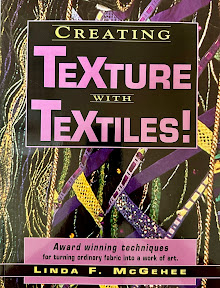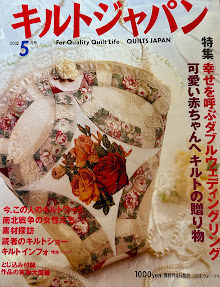 The Twisted Nuts sewing group, with the results of our fabric discharge experiments from last weekend. From left are Linda P. (who organized the event at her house), Linda J., Nancy, and me. Doesn't "Nancy and the Two Linda's" sound like a girl group from the '60s? Carolynn is the fifth member, but she wasn't there because she was recuperating from training so she can bicycle from Seattle to Portland. Is she nuts, or what?
The Twisted Nuts sewing group, with the results of our fabric discharge experiments from last weekend. From left are Linda P. (who organized the event at her house), Linda J., Nancy, and me. Doesn't "Nancy and the Two Linda's" sound like a girl group from the '60s? Carolynn is the fifth member, but she wasn't there because she was recuperating from training so she can bicycle from Seattle to Portland. Is she nuts, or what?
WHAT THE HECK
IS FABRIC DISCHARGE?
and
WHY ARE WE CALLED
THE TWISTED NUTS?
IS FABRIC DISCHARGE?
and
WHY ARE WE CALLED
THE TWISTED NUTS?
Glad you asked! Discharging -- for fabric artists, at least -- means removing color from fabric. Black fabric (cotton, rayon or linen) is often used because when you remove the color, with bleach or another discharge product, you can end up with anything from gray to tan to orange to green. You can keep part of the fabric black by covering that area with a "resist," which keeps the bleach from getting to that part of the fabric. For our resists, we experimented with pressed leaves, masking tape, buttons, and freezer paper.
Above, I used masking tape for my resist to create a design that reminds me of African mud cloth. This is how it looked before I sprayed it with bleach.
Linda P. used freezer paper cutouts (above) that she ironed onto her fabric and then topped with flattened ferns for her resists. Below, she sprays a mixture of half bleach and half water onto it. (We did this outside because you really shouldn't breathe in those bleach fumes. I held my breath while I sprayed and then backed away. If I were to do more of this, I would invest in a respirator.)
 Here is Linda's end result. After she sprayed the bleach, she waited a few minutes while the fabric discharged, revealing a rich pumpkin color. Next, she plunged it into a bin of water, then into a bin with a product called Anti-Chlor (which stops the bleach action), then into hot soapy water. This was all set up on her back patio.
Here is Linda's end result. After she sprayed the bleach, she waited a few minutes while the fabric discharged, revealing a rich pumpkin color. Next, she plunged it into a bin of water, then into a bin with a product called Anti-Chlor (which stops the bleach action), then into hot soapy water. This was all set up on her back patio.While our fabric soaked in the soapy water, Linda served us lunch of tuna salad sandwiches and tomato basil soup. Delicious. Then she tossed everything in the dryer and we were done! We spread our pieces out on her living room floor, took some pictures, and then pulled out our other sewing projects and some art quilt books and magazines and whiled away the rest of the afternoon at Linda's dining room table.
Two excellent books that detail the discharge process are "Create Your Own Hand-Printed Cloth," by Rayna Gillman, and "Complex Cloth," by Jane Dunnewold.
There are a lot of other variables to explore, including using bleach pens, Soft Scrub, dishwasher gels that contain bleach, and discharge paste. If I do any more work with bleach, I repeat, I will invest in a respirator.
 This piece (above) was created by placing old buttons on the fabric as resists. Below, the dried pieces are spread on the floor. Mine discharged to the lightest, probably because I really saturated mine with bleach. Three of us (including me) used black Kona cotton.
This piece (above) was created by placing old buttons on the fabric as resists. Below, the dried pieces are spread on the floor. Mine discharged to the lightest, probably because I really saturated mine with bleach. Three of us (including me) used black Kona cotton.
BUT WHY ARE YOU THE TWISTED NUTS?
We settled on our name because Linda J. brought a leaf that Nancy identified as a "contorted filbert," which led to "contorted nut" and finally the "twisted nuts."
MAY THE COLOR NOT BE DISCHARGED
FROM YOUR DAY!
FROM YOUR DAY!













1 comment:
Loved the work your group did and the background information you shared!
Post a Comment